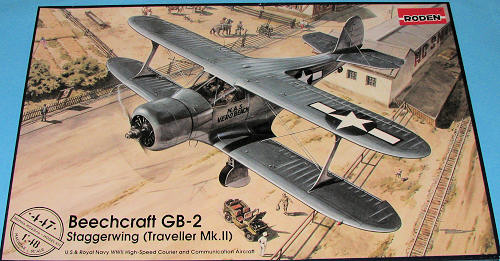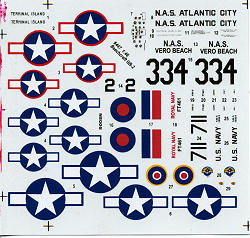
Roden 1/48 Beechcraft GB-2 Staggerwing
| KIT #: | 447 |
| PRICE: | $52.99 SRP |
| DECALS: | Five options |
| REVIEWER: | Scott Van Aken |
| NOTES: |

| HISTORY |
| THE KIT |
 This
is not the first kit of this aircraft in 1/48 scale as AMT released one back
in the late 1960s along with their MiG-15, Meteor, DH-4 and P-36, all of
which have now been superseded by much more accurate and better detailed
kits. Picking this one adds to Roden's somewhat eclectic line of kits. They
seem to pick subjects that are both interesting and able to be done in
several boxings, this one being the second one so done.
This
is not the first kit of this aircraft in 1/48 scale as AMT released one back
in the late 1960s along with their MiG-15, Meteor, DH-4 and P-36, all of
which have now been superseded by much more accurate and better detailed
kits. Picking this one adds to Roden's somewhat eclectic line of kits. They
seem to pick subjects that are both interesting and able to be done in
several boxings, this one being the second one so done. Instructions
are quite well done with lots of well drawn detail to help in construction.
Pa
Instructions
are quite well done with lots of well drawn detail to help in construction.
Pa int
references are Model Master. There are five markings options. Four of them
are USN types with one from Vero Beach, Florida, one from NAS Atlantic City,
one with VRF-3 at Terminal Island and one of an unidentified unit (this is
the one with the red surround insignia). Three of them are in the Tricolor
scheme with variations on the demarcation lines while the fourth has no
white on the underside, that being in intermediate blue as is the side. The
fifth is a British Traveller Mk II as assigned to the RAAEE and it is in
British colors. The large decal sheet is mostly well printed, though the red
surround US insignia and the British fuselage roundel are off register.
Thanks to Roden's rather poor decal reputation, it may be best advised to
replace the insignia with aftermarket ones.
int
references are Model Master. There are five markings options. Four of them
are USN types with one from Vero Beach, Florida, one from NAS Atlantic City,
one with VRF-3 at Terminal Island and one of an unidentified unit (this is
the one with the red surround insignia). Three of them are in the Tricolor
scheme with variations on the demarcation lines while the fourth has no
white on the underside, that being in intermediate blue as is the side. The
fifth is a British Traveller Mk II as assigned to the RAAEE and it is in
British colors. The large decal sheet is mostly well printed, though the red
surround US insignia and the British fuselage roundel are off register.
Thanks to Roden's rather poor decal reputation, it may be best advised to
replace the insignia with aftermarket ones. | CONCLUSIONS |
I'm sure that many are quite pleased that this one has been released and I'm equally sure that many civil boxings are in the offing. Thanks to the minimal rigging, this is one I can handle and I'm already underway on the build so stay tuned.
| REFERENCES |
Roden web site My thanks to
Squadron Products for the review kit. Get yours today at your local
retailer or ask them to order it in for you. August 2011
If you would like your product reviewed fairly and quickly, please contact me or see other details in the Note to Contributors.